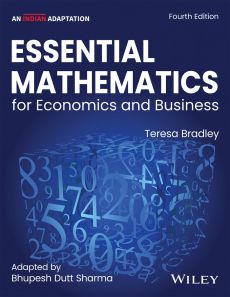Essential Mathematics for Economics and Business, 4ed (An Indian Adaptation)
ISBN: 9789363863446
498 pages
For more information write to us at: acadmktg@wiley.com

Description
This comprehensive resource adopts a metacognitive approach to learning, empowering students and faculty to set clear objectives, develop structured plans, and assess progress effectively.
Each chapter begins with an overview and clearly defined learning goals, with key concepts and formulas prominently highlighted for quick reference. Designed to make mathematics an indispensable analytical tool, the book seamlessly integrates practical applications in economics and business, including demand, supply, cost, and revenue functions.
The text covers essential topics such as financial mathematics, calculus, and more, ensuring a well-rounded foundation for economics students. To enhance understanding, it features visual aids like graphs and charts, often created using Excel, making complex concepts accessible and engaging.
Ideal for educators and students, Essential Mathematics for Economics and Business bridges the gap between theoretical concepts and real-world applications, ensuring success in both academic and professional pursuits.
Introduction
CHAPTER 1 Mathematical Preliminaries
1.1 Some Mathematical Preliminaries
1.2 Arithmetic Operations
1.3 Fractions
1.4 Solving Equations
1.5 Currency Conversions
1.6 Simple Inequalities
1.7 Calculating Percentages
1.8 The Calculator. Evaluation and Transposition of Formulae
1.9 Introducing Excel
CHAPTER 2 Simultaneous Equations
2.1 Solving Simultaneous Linear Equations
2.2 Equilibrium and Break-even
2.3 Consumer and Producer Surplus
2.4 The National Income Model and the IS-LM Model
2.5 Excel for Simultaneous Linear Equations
2.6 Summary
CHAPTER 3 Non-linear Functions and Applications
3.1 Quadratic, Cubic and Other Polynomial Functions
3.2 Exponential Functions
3.3 Logarithmic Functions
3.4 Hyperbolic (Rational) Functions of the Form a/(bx + c)
3.5 Excel for Non-linear Functions
3.6 Summary
CHAPTER 4 Financial Mathematics
4.1 Arithmetic and Geometric Sequences and Series
4.2 Simple Interest, Compound Interest and Annual Percentage Rates
4.3 Depreciation
4.4 Net Present Value and Internal Rate of Return
4.5 Annuities, Debt Repayments, Sinking Funds
4.6 The Relationship between Interest Rates and the Price of Bonds
4.7 Excel for Financial Mathematics
4.8 Summary
CHAPTER 5 Differentiation and Applications
5.1 Slope of a Curve and Differentiation
5.2 Applications of Differentiation, Marginal Functions, Average Functions
5.3 Optimisation for Functions of One Variable
5.4 Economic Applications of Maximum and Minimum Points
5.5 Curvature and Other Applications
5.6 Further Differentiation and Applications
5.7 Elasticity and the Derivative
5.8 Summary
CHAPTER 6 Functions of Several Variables
6.1 Partial Differentiation
6.2 Applications of Partial Differentiation
6.3 Unconstrained Optimisation
6.4 Constrained Optimisation and Lagrange Multipliers
6.5 Summary
CHAPTER 7 Integration and Applications
7.1 Integration as the Reverse of Differentiation
7.2 The Power Rule for Integration
7.3 Integration of the Natural Exponential Function
7.4 Integration by Algebraic Substitution
7.5 The Definite Integral and the Area under a Curve
7.6 Consumer and Producer Surplus
7.7 First-order Differential Equations and Applications
7.8 Differential Equations for Limited and Unlimited Growth
7.9 Integration by Substitution and Integration by Parts
7.10 Summary
CHAPTER 8 Linear Algebra and Applications
8.1 Linear Programming
8.2 Matrices
8.3 Solution of Equations: Elimination Methods
8.4 Determinants
8.5 The Inverse Matrix and Input/Output Analysis
8.6 Excel for Linear Algebra
8.7 Summary
Additional Chapter
Online Chapter (A)
Online Chapter (B)
Online Appendix (A)
Online Appendix (B)

